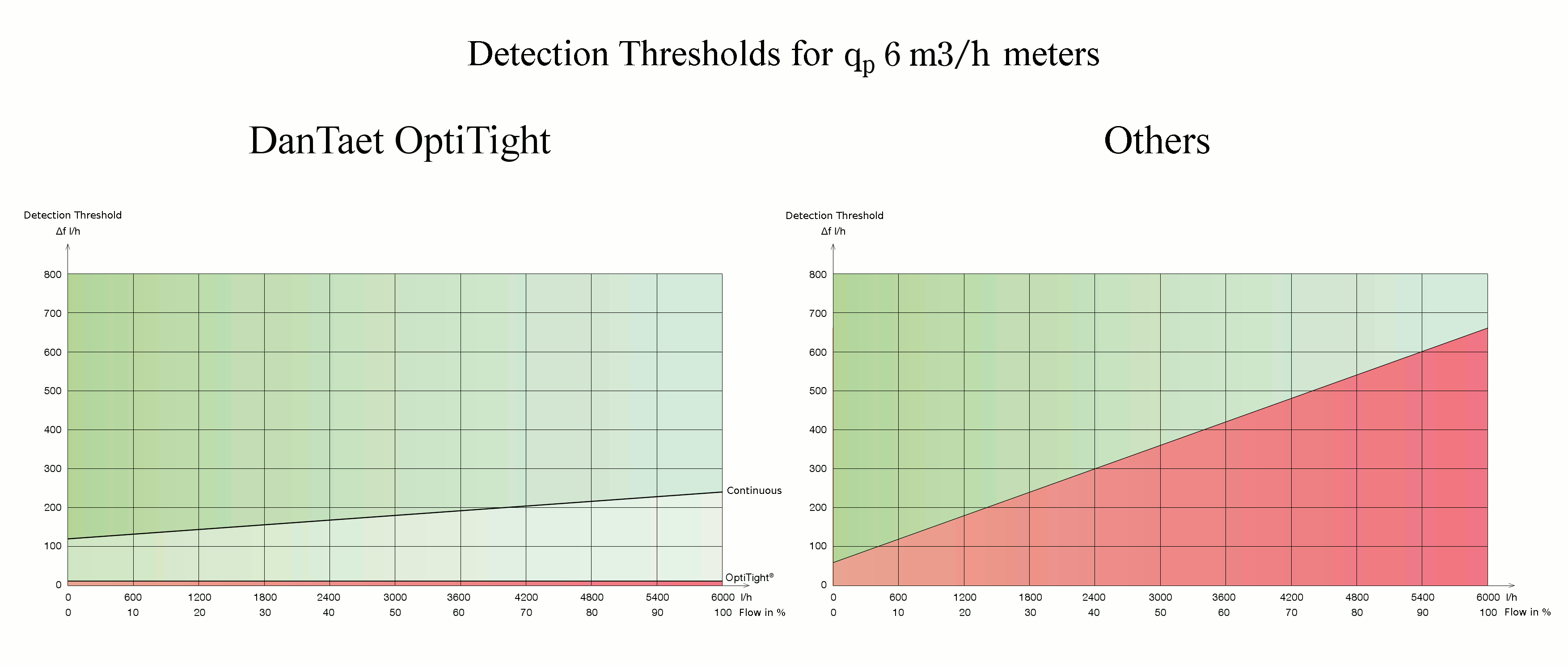Groundbreaking Technologies
|
With the experience from 30 years of operation, DanTaet has accrued a know-how
which inspires new technologies, several of which are patented. A couple of
impotant technologies are these:
|
District Heating Systems
|
OptiTight®
OptiTight® is a procedure for measuring leakages
as small as the minimal flow meter indication, and even less (seepage)
The measurement takes place under asymmetric cut-off, first of the Return pipe,
later of the Flow pipe, while measurement is taken in the branch that is open
to the supply side.
|
If the measurement demonstrates a flow whch after a while does not decline
but remains constant, a seepage has been detected. This may be visible or hidden,
e.g. between the primary and secondary circuits of a calorifier.
OptiTight® is an order of magnitude more sensitive
than difference flow monitoring.
|

|
The sloping line denotes detection threshold versus flow for a typical DanTaet
difference flow monitor.
The horizontal line separating the green and red background colors denotes the
detection threshold for DanTaet OptiTight®.
Only seepage corresponding to the red area below the horizontal line escapes detection.
Seepage corresponding to the green area betwee the two lines is detected by the
seepage monitor, while leakage corresponding to the green area above the slanted line
is detected by the difference flow monitor.
|
The above graph illustrates how a common difference flow monitor permit a sizable
leakage (the red area).
The OptiTight® technology is patented by DanTaet.
No-one else offers this level of sensitivity.
|
ALOHA®
ALOHA® is a mechanism that handles the passage of air
pockets through the flow meters.
When an air pocket passes through an ultrasonic flow meter, its sound-refplective
mirrors can be bared, whereby the meter can no longer perform flow measurements.
This causes the indication of zero flow in one branch, while the other branch
indicates a nonzero flow. Such a condition will after a while cause an alarm from
the difference flow monitor.
ALOHA® recognizes this condition, and responds by
increasing the error criterion a number of times, delaying the alarm and providing
time for the pocket to pass through the flow meter.
The increase of error criterion is largest a low flows, decreasing to 0 at 25% of Qp.
|
 Air pockets can be source of many false alarms, but are effectively handled by
ALOHA® which thereby contributes to the excellent reliability
of the DanTaet systems. ALOHA® is patented.
Air pockets can be source of many false alarms, but are effectively handled by
ALOHA® which thereby contributes to the excellent reliability
of the DanTaet systems. ALOHA® is patented.
|
Supply Water Systems
|
|
|
Discharge Monitoring
A classic way of detecting leakage in a supply water installation is discharge
monitoring. This employs a counter, which accumulates consumption taking place
above a certain base flow (cutoff, C), and which is zeroed when the consumption
flow drops below the base flow. Thusm the base flow marks the beginning and the
end of a discharge. For single family homes, the base flow is typically set at 15 l/h.
Leakage giving rise to flows lower that the base flow must be detected by other means.
|
PSALM®
The PSALM® technology does no employ a single counter for
discharge, but rather a large number of parallel counters, each registering consumption
within a narrow band of flows, and which together cover the full flow domain (spectrum).
Each counter aggregates consumption at flows between its upper and lower limits, and
each counter is reset as the flow drops to or below its lower limit.
The individual counters now represent columns in the flow spectrum.
|

|

|
The discharge monitor is useful in single family homes, where the number of individual
consumers is limited.
At universities and in apartment blocks where the number of individual consumers is high,
long periods of sustained high flow may occur, and it will be necesary to raise the base
flow that defines the beginning and end of a discharge in order to operate with a
reasonable alarm limit, whereby a larger domain of leakages is left for other mechanisms
to detect.
The above graph illustrates how a classic discharge monitor accumulates all consumption
above the base flow, to finally reach the alarm limit (A) despite consumption being in
decline at the time of the alarm.
|
By summing all the individual flow band counters you obtain a discharge that grows with
constant or increasing flow, but which may reduce with declining flow, and which may
therefore operate with a lower alarm limit that the classic discharge monitor - or
operate with fewer false alarms at the same alarm limit.
Because PSALM® operates with many flow bands (high
selectivity), the mechanism can also mitigate some of the disadvantages frequently
encountered, such as limited resolution on flow meter pulsers, or limited update
frequency of electronic water meters. PSALM® is
patent pending, is employed by system KMP-V, and will be employed in future
DanTaet supply water leakage protection systems.
|
|
|

|
|